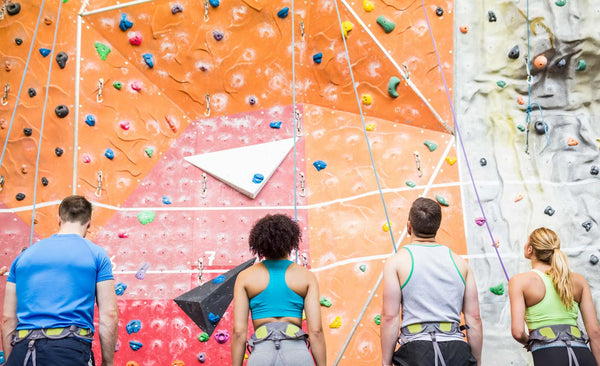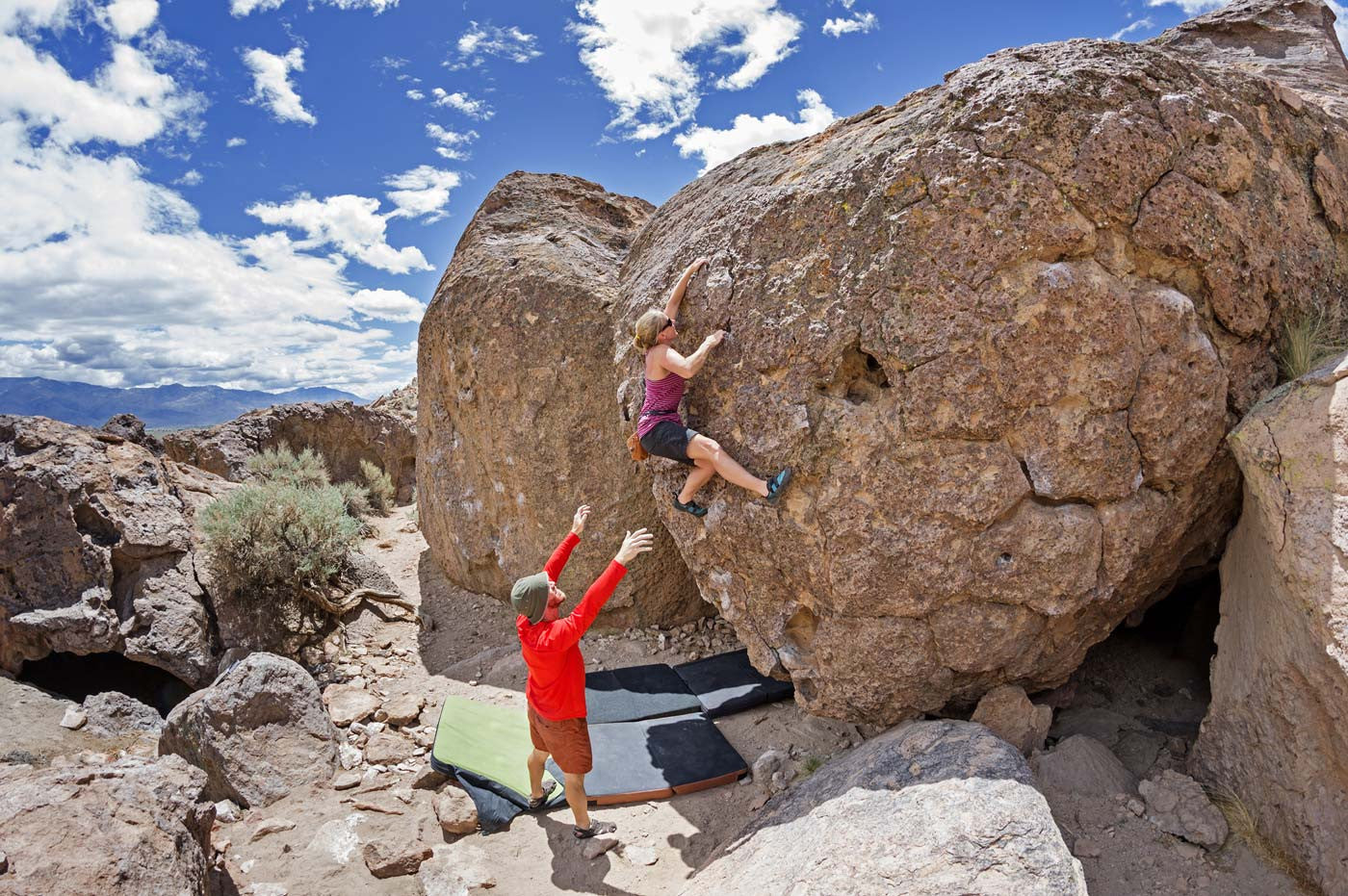Your friend – a V4 climber – has just groveled her way through her first V5, and has arrived at the sloping, unrealistic mantle topout. Her legs shake as if channeling the ghost of Elvis. Her breathing is erratic; uncontrollable gasps of fatigue and panic sputter from her lips. Her elbows are splayed out at 90 degrees – the classic chicken-wing that any terrified, pumped climber knows so well. She is gripped. You do some quick mental math and calculate an 87% chance of failure – unfavorable odds for a climber who’s about to deck from seventeen feet.
As you assault your friend with unconvincing shouts of encouragement, a nagging question haunts your mind: Am I spotting correctly?!

If you’re a boulderer – we’re talking the whole scale here, from gym noob to outside-only grizzled veteran – learning proper spotting technique is absolutely essential. The benefits are many:
- Your skills will increase the morale of your group, and more of your peeps will send.
- Your climbing session will go as long as possible because no one gets injured or dies.
- No one will hate you for missing an easy spot.
- Everyone will love you and see you as a spotting deity.
A Note on Spotting in the Gym
Climbing gyms may seem like places of relative safety. In reality, you’re almost as likely to suffer an injury indoors as you are outside. Many gym climbers don’t see past the veil that a warm building full of soft foam and pumping dance music provides, and therefore take greater risks – i.e. crazy dynos, blind drop-offs, sometimes even backflips. Do not hesitate to use your savvy spotting skills indoors where appropriate! And no, we’re not talking about running to the other side of the gym to join the crowd already spotting that girl. Everyone deserves to feel safe while climbing inside. Plus, you’ll only increase the positivity and support of the gym atmosphere by looking out for other climbers. Maybe you’ll even make some new friends. Don’t just sit and watch people take wild falls from the top of the wall – if the situation calls for it, put your hands up and spot them! Be especially vigilant when you see someone (1) with her body parallel to the ground, (2) with her feet above her head, (3) executing a heel hook high off the ground, or (4) jamming her hand or foot between two holds.
We believe possessing good technique in all aspects of rock climbing – not just having the dopest gear – serves our sport and the enjoyment we get from it. So here are 7 spotting tips we’ve compiled for you. May they make your transition into the role of “professional spotter” as seamless as possible.
-
Assess the Landing

Good spotting technique begins with the arrangement of the landing zone. Analyze the line being climbed, do your best to determine where the fall zones will be, and plan accordingly. Make sure the area is free of any objects other than a pad. As we’ll explain below, the main objective of spotting is to guide your buddy onto the pads. So don’t neglect this first step. If your friend sketches off the climb and breaks her ankle because of a stray water bottle or poor pad placement, your amazing spotting technique is completely irrelevant.
-
Communicate

Figure out the climber’s intentions before they actually start climbing. Which line are they climbing? Where is the crux? Are they about to go a muerte on this rig?! Knowing the what, how, and where of every situation is essential to providing a legendary spot.
-
Position Yourself
Once you figure out the essentials of Step 2, you’ll have a good idea of where you should stand to maximize the effectiveness of your spot. Once you’re there, harness the power of the bouldering forefathers and get in the classic spotting stance: head up with your eyes on the climber, knees and elbows bent, hands extended towards the climber with your thumbs tucked in line with your index finger (because a climber’s full weight landing on your thumb = broken thumb).
-
Your Hips Don’t Lie

While the climber struggles through her project, keep your eyes on her hips. This is roughly where her center of gravity lies, and where you want to focus your spotting energy when the inevitable fall happens. When she falls, you’ll know the trajectory her body will follow based on her center of gravity.
-
SHE IS FALLING

The time has come. What do I do?!? First of all, stay calm, or you may end up punching your friend in the leg during her fall, pitching her helpless body into a frenzied spiral of impending injury. Instead, stay focused on her center of gravity as she falls and direct your outstretched hands towards a point on her back, ideally between the shoulders. The point of spotting is to direct a falling climber onto the crash pads by giving them a controlled, stable touch. DO NOT try to catch them! Unless, of course, you want to hurt yourself and your friend. And oh yeah, unlike the guy in the photo, keep your thumbs in line with your hands!
-
Protect Ya Neck
Ideally, a falling climber will execute a cat-like twist in midair and land perfectly on her feet. Or – like a ninja – she’ll twist and land on one foot and one knee, fist to the ground, then slowly raise her head to stare into your soul. This happens rarely. But it does happen.
In actuality, most people flail back to the earth like a blubbering mass of disembodied tentacles, or a flightless bird. If your friend is falling like this – which happens quite often – your primary objective should be to spot her onto the pads. If she falls erratically, try to protect her head, neck, and shoulders from hitting anything that does not qualify as “crash pad.” Hopefully you’ve arranged everything to protect against this, but it can still happen.
If you see that her head might be careening towards a rock, make a cradle with your hands and make every effort to place said cradle between the rock and her skull. DO NOT jerk your hands up and try to catch her head like a football; this is how you give your friend a solid neck injury.
-
Assess the Post-Fall Damage
Well, usually there is no damage, but you still want to check. Ask your friend if she’s okay. Analyze your pad setup, your spotting technique, and the way she fell. Then apply your newfound knowledge to the rest of the climbing day. Repeat until you feel comfortable entering yourself into professional spotting competitions. You may have to wait twenty or thirty years until such comps exist.
Conclusion
All jokes aside, proper spotting technique makes a huge difference in the indoor and outdoor bouldering worlds. Spotting strengthens the camaraderie, trust, and safety of rock climbing, and pushes the limits of the sport higher and higher. After all, we’re social animals. Who would ever want to climb a 25-foot V13 without a spotter?
--
You crave the moment where your grip does more than you thought it could. That split second is nirvana. At FrictionLabs, we help you find that feeling. We use science to engineer the best chalk anywhere. Try It to experience better performance, safer breathing, and healthier skin.

